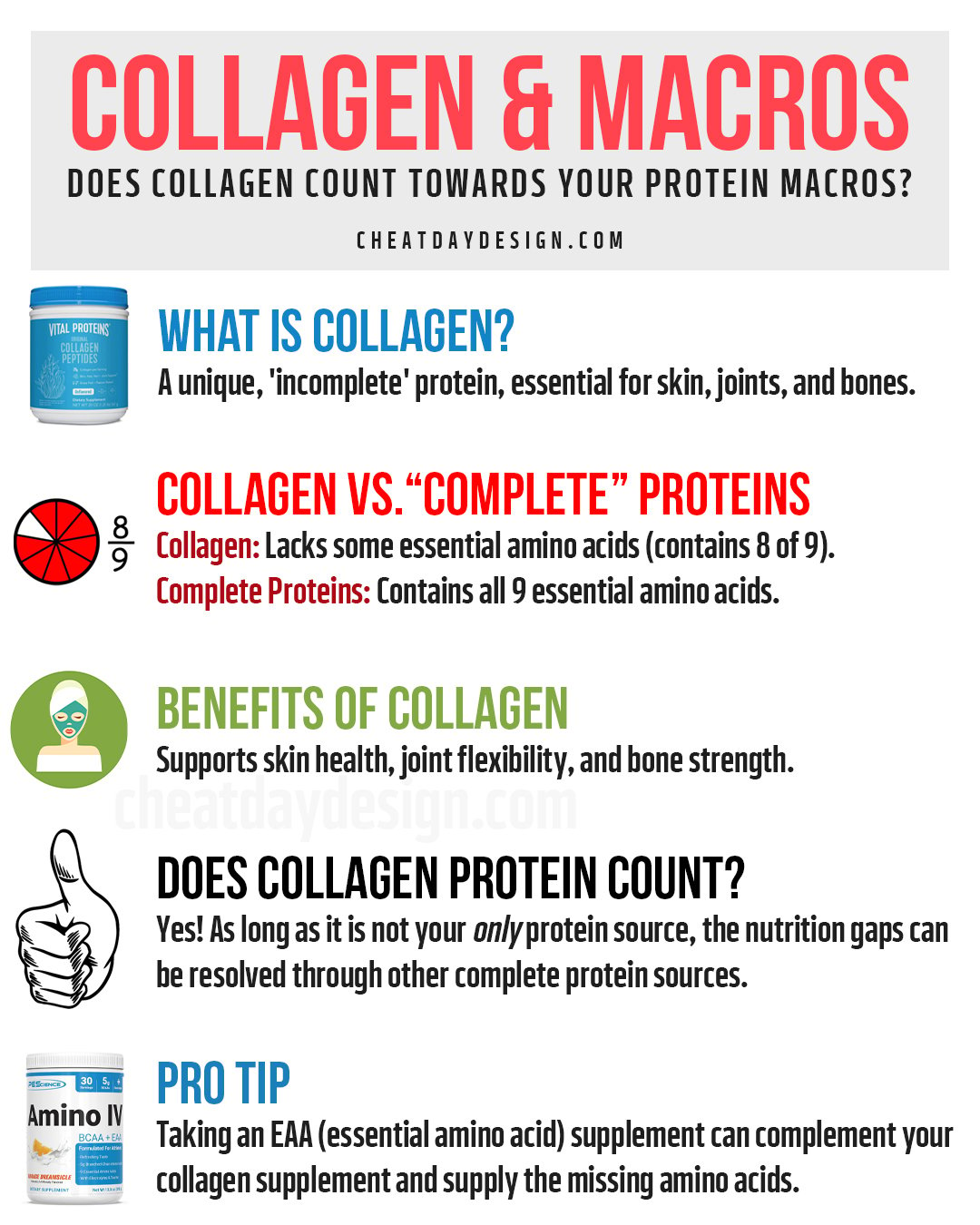We’re diving into a tricky protein question that confuses even the most experienced macro-trackers: Should collagen be considered part of our protein macros?


Highlights
- Collagen is considered an “incomplete” protein because it lacks certain amino acids, leading to debates about whether it should be included in protein macro calculations.
- Nutrition labels may be misleading regarding collagen’s protein content due to its incomplete nature, but advancements like the PDCAAS (Protein Digestibility Corrected Amino Acid Score) are helping to provide more accurate reflections of protein usability.
- Collagen should be considered more like a supplementary protein source rather than a primary one due to its lack of all essential amino acids, but it can still count towards total protein intake if the rest of the diet is balanced with a variety of protein sources.
Many protein snacks and supplements highlight collagen, which makes counting our macros a bit confusing. Although collagen is a type of protein, it goes a bit deeper than that.
Collagen is what we call an “incomplete” protein because it lacks certain amino acids. This leads to a big question mark over including it in our protein macro calculations.
If you’re new to tracking macros or just getting the hang of it, don’t stress. Keeping things simple is what my content is all about.
Here, my goal is to explain hard science in a way that’s straightforward for everyone to understand. So, if you’re confused, you’re in the right place.
Macro tracking doesn’t have to feel like trying to crack a complicated secret code. At the end of the day, protein is protein, right? While I don’t recommend collagen as your only protein source, adding it to your diet can bring great benefits – as long as you keep your amino acids balanced.
Let me clear up any doubts about collagen’s role in your protein intake and make it as simple as possible.
The Basics of Macros: What You Need to Know
When you start tracking your macros, you’re keeping track of the major nutrients (macronutrients) your body needs: carbohydrates, fats, and proteins.


These are the building blocks of your diet and play different roles in energy, growth, and bodily functions. Carbohydrates are your body’s main energy source, fats provide essential fatty acids and help absorb vitamins, while proteins are crucial for building and repairing tissues, including muscles.
Proteins are made up of amino acids, some of which your body can’t make on its own—these are known as essential amino acids. They are appropriately named because it is essential that you get these from your diet.
But you are certainly not expected to track your amino acid intake- that’s taking it way overboard.
Instead, as a macro-tracker, you’re just going to make sure you are hitting your protein goal for the day. As long as your diet consists of a variety of protein sources, you should have no problem getting the amino acids your body needs.
So, why the collagen confusion? Let’s get into that.
Collagen Confusion in Macro Tracking
One area where people often get tripped up with macro tracking is differentiating between various types of proteins. Not all proteins are created equal, and this is especially true when we talk about ‘complete’ and ‘incomplete’ proteins.
Complete proteins contain all nine essential amino acids in sufficient quantities.
Incomplete proteins, on the other hand, lack one or more of these essential amino acids.
This is where collagen gets tricky—it’s an incomplete protein. Because of this, a lot of people recommend not counting collagen towards your protein goals (which is precisely why I felt the need to write this article).
To give a little bit of context, essential amino acids are the amino acids your body can’t produce and must come from your diet. A complete protein provides all nine of these in sufficient amounts, which is crucial for maintaining muscle mass, supporting metabolic processes, and overall health.
Why is this so important? Well, each essential amino acid has a unique role in the body, from muscle repair (like leucine) to neurotransmitter support (like tryptophan).
When a protein source lacks one or more of these, like collagen lacking tryptophan, your body may not perform at its best.
Does that mean collagen isn’t useful or beneficial? Of course not! But its incomplete nature is why you’ll often see people recommending that you don’t count it towards your protein.
Tracking Macros: Collagen IS a Protein Source
Collagen is often touted for its health benefits, particularly for skin, hair, and joints. It’s a protein, but it’s different from the proteins you find in something like meat or beans.



Found in connective tissues, collagen is abundant in our bodies. As a protein source, though, it’s incomplete because it doesn’t contain all the essential amino acids—most notably tryptophan.
This doesn’t mean collagen isn’t useful. It contains plenty of other amino acids like glycine, proline, and hydroxyproline in large amounts, which can support tissue repair and other body functions.
When considering collagen in your diet, it should be looked at much more like a supplementary protein source than a primary protein source.
Does that mean it shouldn’t count towards your macros? Not at all.
When it comes to collagen, we’re often just consuming a single scoop as a supplement. If we assume that a scoop of collage is roughly 15-20 grams of protein, that should certainly count towards your total protein.
As long as the rest of your diet is balanced, and you are consuming protein from a variety of sources such as meat, dairy, plants, etc, then you will be getting plenty of amino acids in your diet to more than make up for what collagen is lacking.
What Does The Research Say?



When it comes to understanding collagen’s role in protein macros, there’s no better place to turn than scientific research. A study published in the National Center for Biotechnology Information provides some interesting insights.
Researchers found that collagen peptides did contribute to muscle mass increases in aging mice. This is a fascinating outcome, but it’s worth noting that the mice were also fed with an overall balanced diet.
What’s the takeaway? Well, this study suggests that collagen can play a part in maintaining and potentially enhancing muscle mass, especially when combined with a balanced diet.
If you’re adding collagen to a diet that already includes a variety of complete protein sources, it could boost your overall protein levels.
Keep in mind, the study also highlights the importance of context. The mice weren’t just eating collagen—they had a balanced diet too. This emphasizes the importance of diversity in your protein sources. Plus, we are not mice, so it is not exactly apples to apples, but it provides some helpful insight.
In short, collagen can contribute to your protein macros, but it’s best used as a supplement to, not a replacement for, complete protein sources. Achieving the right balance is always key.
We’re constantly learning and evolving our understanding of nutrition, and each new study contributes a piece to the puzzle.
Nutrition Labels and Collagen
Nutrition labels can be a bit misleading when it comes to collagen. You might see a protein bar or cookie with a high protein count and not realize that a chunk of that protein is from collagen.



You’ve probably never heard about the PDCAAS (Protein Digestibility Corrected Amino Acid Score), but it is a way to measure the quality of a protein. It isn’t widely used (yet), but a lot of products have begun using this on their labels as a way to show how much protein in a product your body will fully utilize.
PDCAAS measures both amino acid content and protein usability, giving us a score between 0 and 1. The higher the score, the better the protein.
Complete proteins like whey and soy usually score a 1, meaning they’ve got all essential amino acids and are easily digested.
How does collagen rank on the PDCAAS scale?
Unfortunately, collagen has a score of 0 because of its lack of tryptophan and lower levels of certain essential amino acids. This is another reason why collagen isn’t considered a “complete” protein, and why it’s more of a supplemental source rather than a primary one.
As consumers become more health-conscious, the use of PDCAAS will continue to grow. When a product uses the PDCAAS, the protein content will be adjusted to show you the true protein for that product.
For example, I created a protein pancake mix with PEScience, and we used the PDCAAS for honest labeling. While the product contains 19 grams of total protein, you’ll only see 15 grams on the nutrition label due to the adjusted score.
I know, that was a lot to take in. Here’s the takeaway:
As we move forward, more and more labels will use honest labeling practices and the protein content will be reflective of what you should (or shouldn’t) be tracking.
But, as it currently stands, I recommend simply tracking whatever the nutrition label says, collagen or not. Keep it simple.
Can Amino Acid Supplements Fill in the Gaps?
So we’ve established that collagen isn’t a complete protein because it lacks certain essential amino acids, but what if we could fill in those gaps? That’s where amino acid supplementation comes in.
By pairing your collagen intake with an amino acid supplement, you can ensure that your body is getting all the essential amino acids it needs to function at its best. But, keep in mind, a well-rounded diet should always be your first line of defense over supplements.
However, if you’re someone who struggles to get all their amino acids from their diet, supplements can certainly help.
The most common amino acid supplements are BCAAs (Branched-Chain Amino Acids) and EAAs (Essential Amino Acids), and it’s important to understand how they differ.



BCAAs are made up of three of the nine essential amino acids: leucine, isoleucine, and valine. These play a significant role in muscle development and maintenance, making BCAA supplements a go-to for athletes.
On the other hand, EAAs are all nine amino acids that your body can’t produce on its own: histidine, isoleucine, leucine, lysine, methionine, phenylalanine, threonine, tryptophan, and valine. Given that EAAs include all the amino acids found in BCAAs, plus six more, EAA supplements can be viewed as a broader spectrum supplement.
When you’re looking to specifically supplement for collagen, remember this simple rule: EAAs over BCAAs.
Why? Because EAAs contain all of the amino acids that collagen lacks. By adding EAAs to your regimen, you can balance out your intake and ensure your body gets the complete set of essential amino acids it needs for optimal function.
Don’t forget, though, that while supplements can help in certain situations, it’s often best to get your nutrients from whole foods whenever possible. Foods high in EAAs include meat, fish, eggs, dairy products, tofu, and tempeh, so make sure these feature in your diet before you reach for a bottle of supplements.
But if you struggle to get all your essential amino acids from your diet, EAA supplements may be a good addition to your routine.
Final Thoughts: Collagen Counts



I am all about keeping macro-tracking simple. And in the name of simplicity, I believe collagen should count just as much as any other protein source.
If you’re diligently tracking your macros and eating a balanced diet (including complete protein), you’re on the right track.
Adding collagen into the mix can be part of that balanced approach if it’s a supplement you prefer. Don’t get bogged down by the details of complete versus incomplete proteins in every meal, because you will drive yourself crazy.
If most of your protein comes from whole food sources and you’re just supplementing with collagen for its unique benefits, count it towards your daily protein goals. It’s simple!
If your protein intake were comprised entirely of collagen, then my recommendation would certainly be different. But as a supplement, and only a small part of the larger protein puzzle, there is no reason to ignore it.
Keep it simple and balanced, and you’ll be set.





